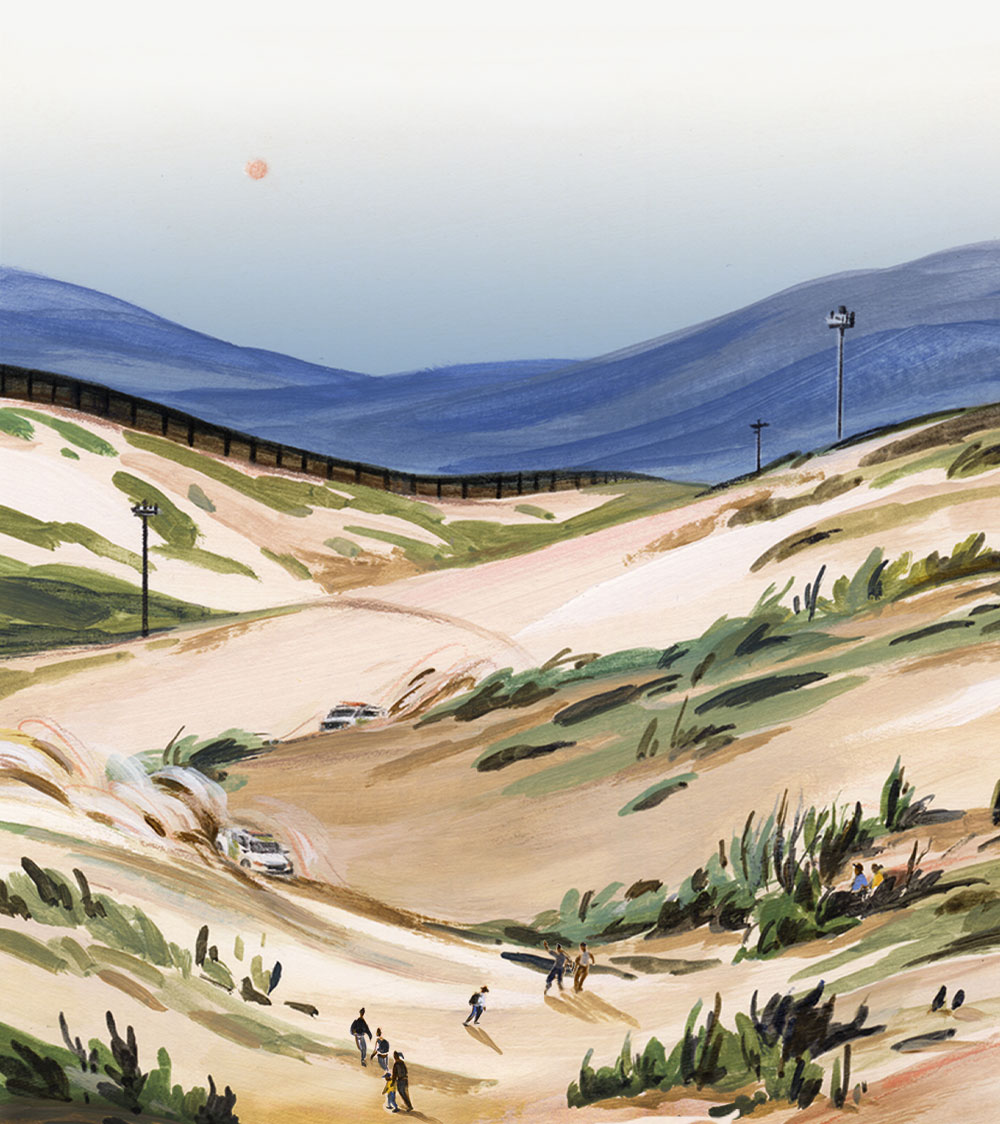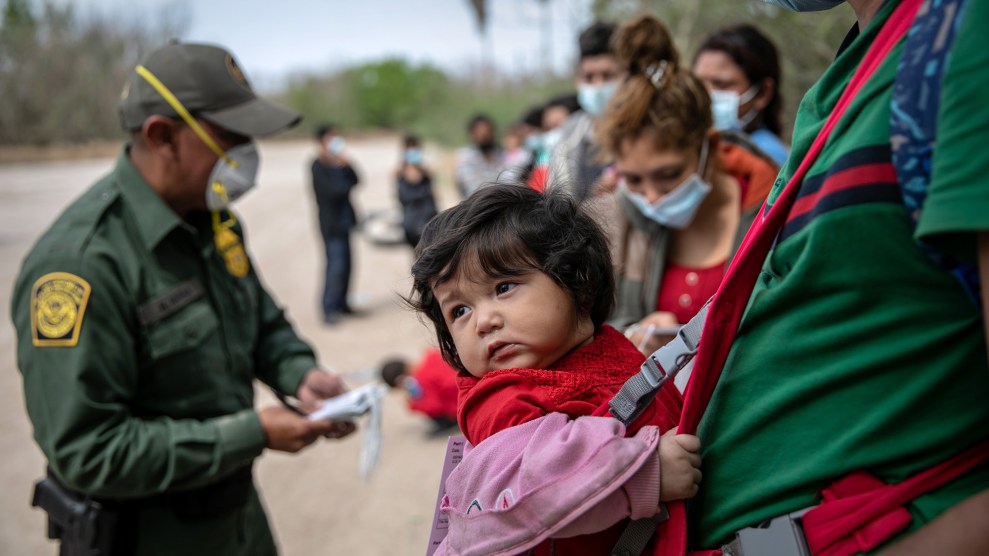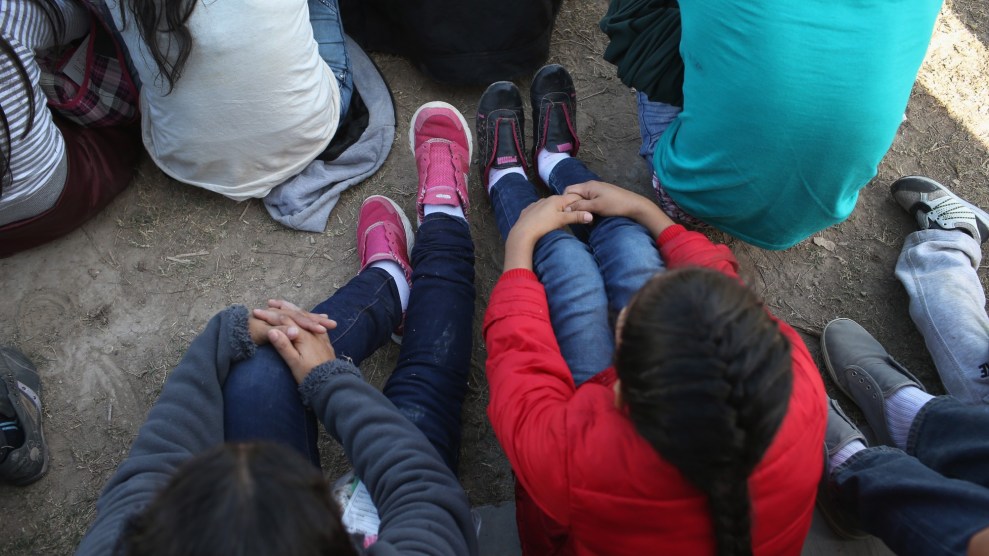This article was published in partnership with The Marshall Project, a nonprofit news organization covering the US criminal justice system.
Migrants were found lost in the desert, tucked under rocks in the mountains, and trapped by the rushing tides of the Rio Grande. Some were experiencing heat exhaustion in 115-degree weather, while others nearly died from hypothermia. In Laredo, Texas, one woman was found falling in and out of consciousness from dehydration. In the Jacumba Mountains of Southern California, a man with a fractured ankle had to be carried out of the impassable terrain in a litter basket. In Arizona, two people were found dead in the desert with the word “HELP” written on the ground nearby.
These are only a few of many reports of search and rescue operations by U.S. Customs and Border Protection (CBP) in 2020—a window into a border region that has become increasingly dangerous, and at times deadly, for migrants over the years.
New data and analysis by The Marshall Project and Mother Jones shows that while the number of encounters at the border fell by half in fiscal year 2020 compared to the previous year, the number of encounters that required a rescue operation doubled to the highest rate in at least a decade. The death rate also nearly doubled during the same period, from 35 to 62 migrants found dead for every 100,000 migrants encountered.
The key factor appears to be that since the onset of the pandemic, the United States has virtually sealed off the Southern border, enforcing a public health code that allows the government to deny non-citizens entry into the country in response to a threat of communicable disease from abroad. In March 2020, former President Donald Trump invoked this rarely used provision, known as Title 42, through the Centers of Disease Control and Prevention to prevent the spread of the coronavirus, despite pushback from the agency’s own scientists.
Prior to Title 42, migrants arriving at the border who claimed fears of returning to their home countries would be screened to determine if they had a legal basis to request asylum in the United States. Now, most migrants and asylum seekers are being expelled back to Mexico or deported to their countries of origin without the opportunity to seek protection.
The policy, which President Biden has so far upheld, has resulted in hundreds of thousands of immediate expulsions. Because these expulsions don’t trigger prosecution for illegal reentry, migrants are attempting multiple crossings, seeking out more remote and perilous sections of the border. Humanitarian groups say these efforts to avoid detection and near-certain expulsion increase migrants’ chances of needing to be rescued—or of dying.
“Even though [migrants] are escaping horrible situations, what they encounter in the borderlands is just as ruthless,” Pastor Randy Mayer, founder of the Arizona-based humanitarian group Green Valley-Sahuarita Samaritans says. “People are taking more risks. We’ve seen that over the last 25 years, but definitely right now they’re being pushed into even more difficult situations.”
Pastor Mayer and the Green Valley-Sahuarita Samaritans search for migrants lost in the Sonoran Desert or leave water for them. They’ve found that after Title 42 was enacted, the further into the desert hills they ventured, the more evidence of migrant crossings they encountered: unscrewed water jugs, discarded bottles and abandoned personal belongings.
Arizona isn’t the only place the migrants’ desperation is visible. Vicki Gaubeca, director of the Southern Border Communities Coalition, a network of more than 60 organizations along the border from California to Texas, says in San Diego they’re “seeing higher numbers of people out at sea and drowning, and more instances of people dying when they fall off the 30-foot wall.”
In a recent blog post, Gaubeca blamed Title 42 for the deaths of three migrants traveling on a boat that capsized near Point Loma, San Diego, leaving dozens of others injured. The fatal accident happened only a few days after CBP ramped up enforcement along that coast, in response to more crossings at sea that have turned “from risky to tragic” in the past year.
“I would lump Title 42 into a box of policies that are designed to, under one guise, keep people out and keep them safe,” says Bradford Jones, a professor of political science at the University of California, Davis, “but really doesn’t resolve any issues.” Instead, he says, it creates incentives to cross and “will lead to more people losing their lives.”
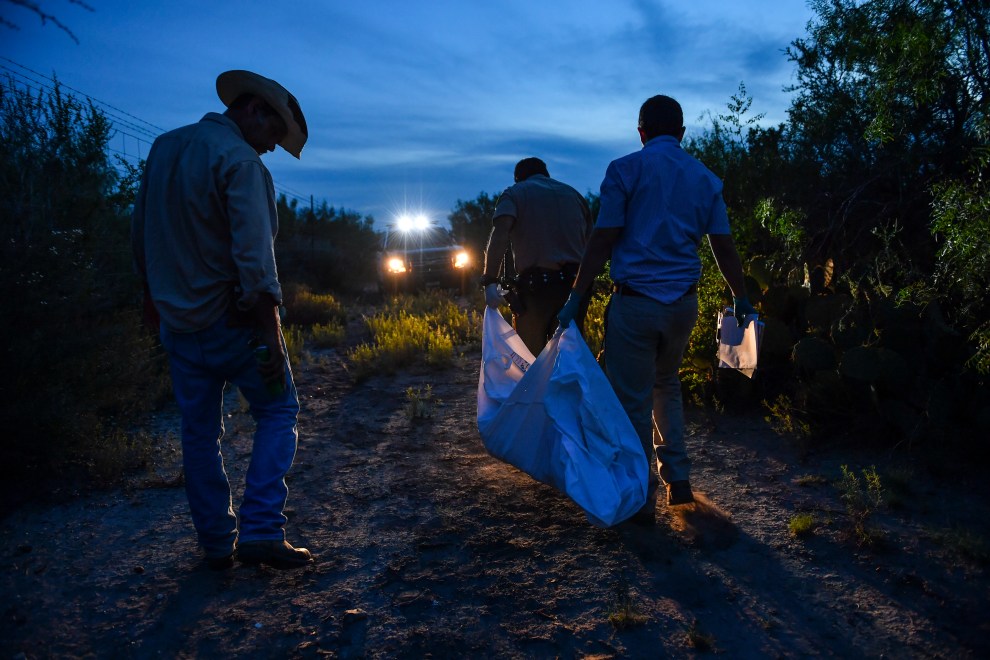
Deceased border crossers are normally found by chance.
The Washington Post/Getty
While several factors—additional Border Patrol agents, operational changes within the agency, circumstances in Mexico and previous policies restricting access to asylum—may partially explain more rescues, Title 42 is “by far the best explanation,” says Aaron Reichlin-Melnick, policy counsel at the American Immigration Council. Even border officials have publicly acknowledged that Title 42 is “motivating some migrants to use risky paths or methods multiple times to avoid arrest.” CBP also reported “an uptick in extremely risky search and rescue scenarios all across the Southwest border” in the summer of 2020.
The agency did not respond to repeated requests for comments on possible alternative explanations for the record high rescue rates last fiscal year. Seven months into the current fiscal year, CBP has already reported 5,787 rescues—532 more than in the entire previous fiscal year. However, border encounters have been rising in recent months, which might explain the increased rescues.
Alan Bersin, former President Bill Clinton’s “border czar” and Commissioner of CBP under former President Barack Obama, said there is no question that Title 42 has led to smugglers taking migrants who “seek alternative means” on more dangerous routes to get into the country—often with “regrettable consequences.”
Migrants have not only been taking more dangerous routes since Title 42—they’re attempting them more than once. Since the policy was first enacted, CBP has conducted more than 730,000 expulsions at the Southern border, most of whom were single adults who had been expelled before. Between March 2020 and February 2021, CBP estimates that 38 percent of all apprehensions involved migrants who had crossed at least once before, compared to recidivism rates ranging from 7 percent to 14 percent in prior fiscal years.
After Biden took office, the agency recorded almost 290,000 expulsions between February and April—almost 40 percent of all expulsions since Title 42 was enacted. But there are some exceptions. A court ruling from November blocked the enforcement of the policy for unaccompanied minors, after at least 13,000 children and teens had already been turned away. Although a later decision allowed the practice to continue, Biden kept the exemption allowing unaccompanied minors entry. Many families are also being let into the country, but in some cases, desperate parents send their children across the border alone to seek asylum and attempt to join them later by taking riskier routes outside ports of entry.
Making the journey multiple times increases the likelihood of harm or fatality. But staying in Mexico comes with its own risks. A recent report released by Human Rights First documented more than 490 instances of violent attacks and kidnappings targeting asylum seekers who were expelled to Mexico under Title 42.
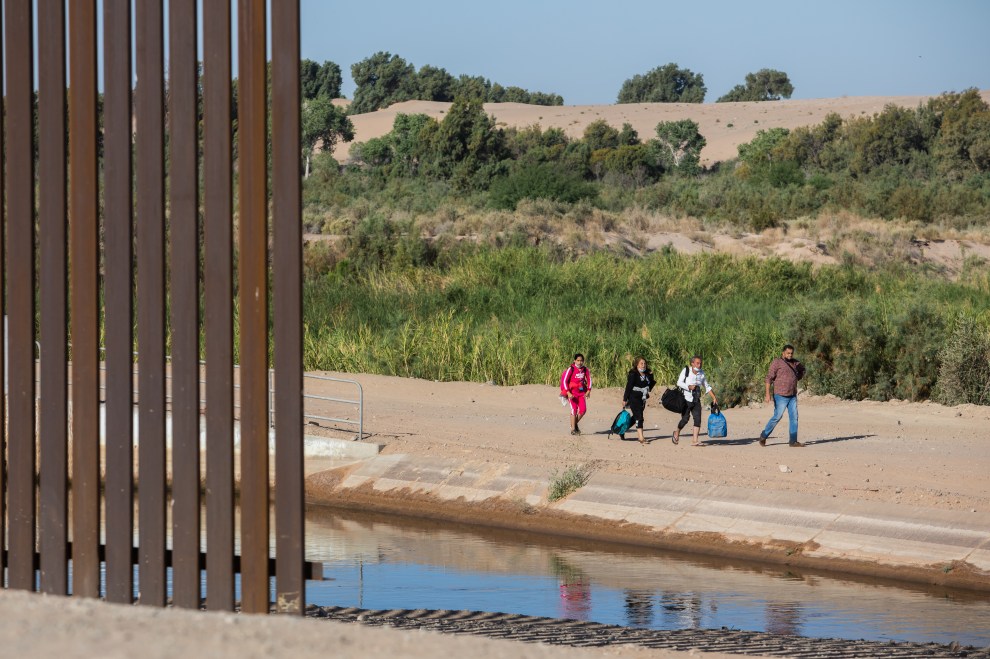
A family of asylum seekers walks through the US Mexico border to turn themselves in to Border Patrol agents on May 13, 2021.
Apu Gomes/Getty
Immigration and public health experts, including CDC senior officials and the United Nations High Commissioner for Refugees, have opposed Title 42, citing due process violations and a lack of public health justification for shutting down the border. Despite growing calls for the Biden administration to rescind the measure, Department of Homeland Security Secretary Alejandro Mayorkas has maintained that the order is a public health tool to protect both Americans and migrants.
“There is no intention to use the CDC’s Title 42 authority for a day longer than the public health imperative requires,” Mayorkas said in April. But as the pandemic winds down in the United States, critics of the policy say the government is keeping it alive to try to manage arrivals at the border and deflect politically charged accusations of “open borders.”
The White House didn’t respond to a request for comment on why it continues to uphold the policy.
The Title 42 policy is only one chapter in a long history of border enforcement policies aimed at making it harder for migrants to make the journey across the border. Starting in 1994 under President Bill Clinton, the U.S. government adopted a “Prevention Through Deterrence” strategy to control the border. The goal was to concentrate enforcement personnel, infrastructure and technology along traditional, high-traffic migration routes in order to funnel migrants towards hostile terrain “less suited for crossing and more suited for enforcement.”
According to two reports by the Immigration and Naturalization Service, which was the predecessor to DHS, the strategy’s success was measured in part by the number of migrant deaths, increases in smuggler’s fees and more complaints from interest groups.
Jenn Budd, a former senior Border Patrol agent hired in 1995, was stationed in Campo, California, during one of Clinton’s programs known as Operation Gatekeeper. Budd recalls that it wasn’t uncommon to find migrants frozen to death in the winter and suffering from dehydration and heat stroke when temperatures reached 112 degrees during the summer. “That’s what deterrence does,” she says. “It kills.”
“CBP has relied on the desert and the killing fields to do the job for them—to be just another enforcement agency—and once you do that, you’re tacitly admitting that you’re going to tolerate death,” says Jones. “History shows us that increased enforcement leads to greater risk taking, and greater risk taking leads to increased death. It’s a simple equation. That’s the legacy.”
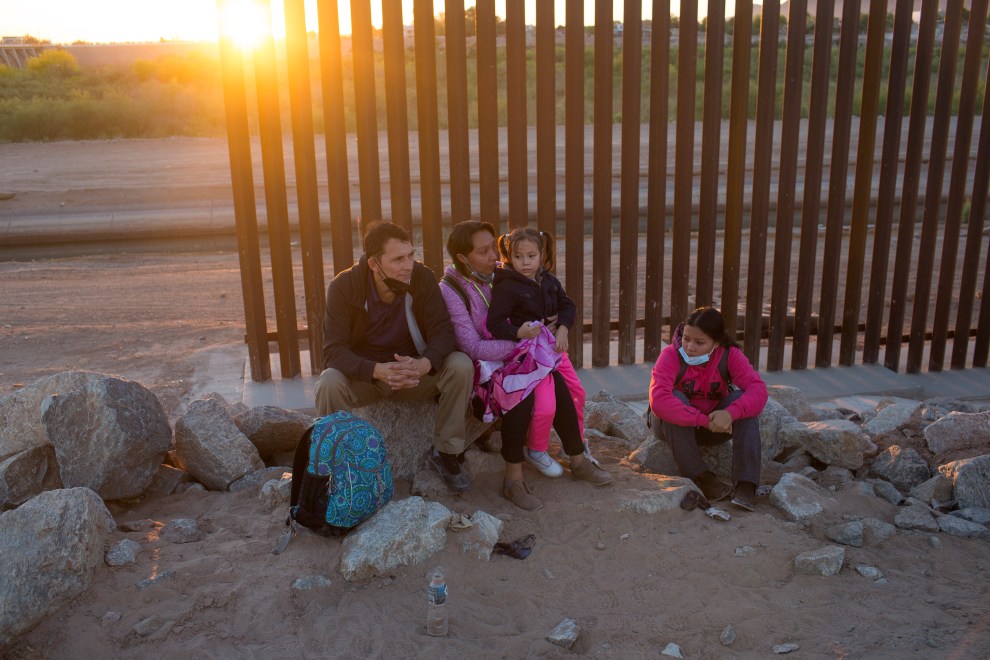
A migrant family from Central America waits to be processed by Border Patrol after crossing from Mexico on April 29, 2021 near Yuma, Arizona.
Andrew Lichtenstein/Corbis/Getty
Decades worth of research show that prevention through deterrence policies has resulted in an increase in migrant deaths and a “crisis of disappearance.” Since 1998, about 8,000 migrants have been found deceased and at least 5,500 people have gone missing in the mountains and deserts of the borderlands, with humanitarian groups estimating the actual numbers to be much higher.
CBP didn’t start tracking deaths and rescues until 1998, the same year the Border Patrol Search, Trauma, and Rescue (BORSTAR) Unit was created “in response to the growing number of injuries to Border Patrol agents and migrant deaths.” Agents in the unit are especially trained to do search and rescue work and improve border safety for migrants, but they represent a small part of the agency’s operation.
Meanwhile, resources for border enforcement have steadily grown. The number of Border Patrol agents has gone from around 4,000 in 1994 to more than 19,000 in fiscal year 2020, and its annual budget increased more than ten-fold to almost $4.9 billion, making it the single largest enforcement agency in the country.
Bersin, who was involved in the creation of BORSTAR, says there is currently a heightened tension between border enforcement and humanitarianism at the border. He says that substantially increasing resources for rescues would prompt proponents of border enforcement to say “we are inviting smugglers to just drop migrants off in dangerous parts of the desert so BORSTAR can go get them.” Meanwhile, Bersin says advocates take the position that “the incapacity of BORSTAR to rescue every migrant placed into a position of danger by smugglers is anti-humanitarian and makes the consequence the responsibility of the government. The polarization is not constructive.”
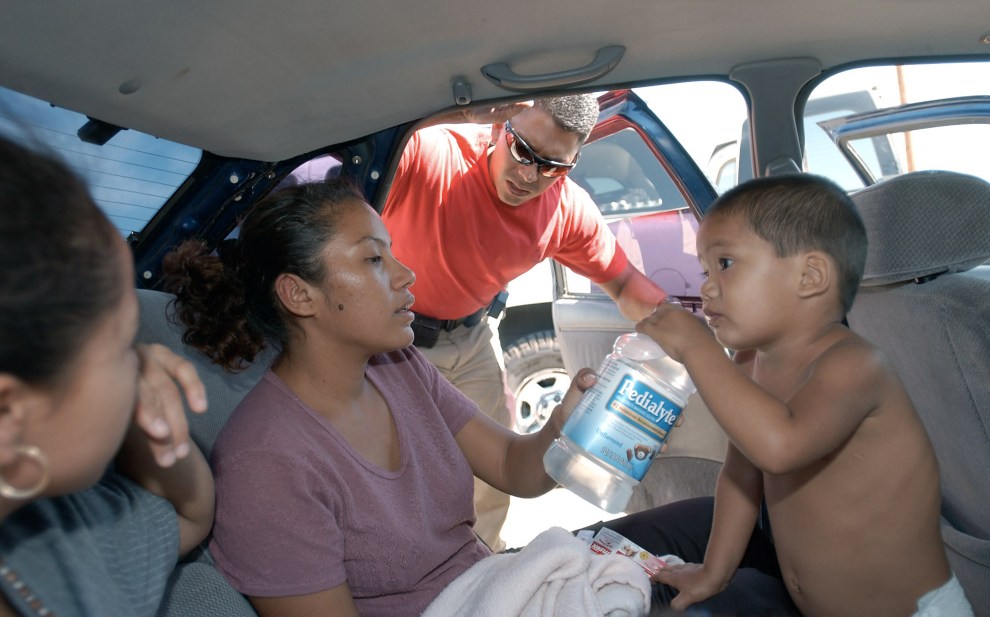
A US Border Patrol Search, Trauma, and Rescue (BORSTAR) team member watches a young dehydrated child drink Pedialyte in the back of a car on July 6, 2002.
Bob Riha Jr./Getty
In the name of border security, both Republican and Democratic administrations have invested in policies that weaponize the border while also criminalizing migrants. Under former President Bush, Operation Streamline, initiated in 2005, sought to deter migration with the threat of criminal prosecution and potential prison sentences for illegal entry. One year later, the Secure Fence Act authorized funding for 700 miles of border fencing and other “physical barriers” from California to Texas. President Obama also imposed harsher penalties for unauthorized migration and expanded family detention as deterrence strategies.
Trump took the logic of militarization and deterrence even further with the border wall and policies like zero-tolerance and the Remain in Mexico program, which Biden recently overturned. And of course, Title 42, which Alyson Ball, chair of the Alliance4Action Immigration Group describes as “prevention through deterrence 3.0.”
Despite years of policies making it harder to cross the border, migration has not halted. “You can’t deter people running for their lives,” says Budd. “If they can no longer drive through, they will jump over, tunnel in, or backpack it across. It’s a matter of life and death.”
“I think we’ve overestimated how effective deterrence can be at managing migrant flows given the factors that push migrants in the first place,” says Theresa Cardinal Brown, a former DHS official and the Bipartisan Policy Center’s managing director of immigration and cross-border policy. The result, she says, is a “race to the bottom to make it so it’s worse to migrate across the border than it is to stay where you are.”
For the time being, Title 42 will remain in place, although the administration is reportedly carving out new exceptions based on humanitarian claims. The prevailing message, however, is that the border is closed. As part of its ad campaigns to discourage migration from Central America, the U.S. government offers a warning in the form of a testimonial from someone who made the journey: “You will suffer a lot on the way.”
Fernanda Echavarri of Mother Jones and Ariel Goodman of The Marshall Project contributed reporting.
